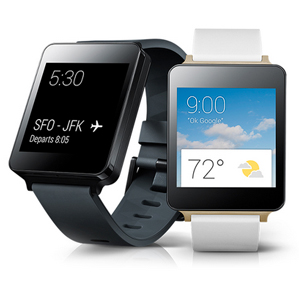In Bid to Define Wearables, Google Offers Two Smart Watches
Google will begin selling two smart watches through its online store today, the first products to be made available in the company’s push to see its Android software power a new generation of devices that are worn on the body.

LG’s G Watch and Samsung’s Gear Live both have touch screens and connect with a smartphone. They run a version of Google’s Android mobile operating system dubbed Android Wear, and their functionality depends heavily on the company’s services and voice recognition software.
“We’re right at the beginning of a new phase in the miniaturization of technology,” said David Singleton, a director of engineering in Google’s Android division, speaking at the company’s I/O event in San Francisco today. “It’s finally possible to make a small computer that can fit comfortably on your body all day long.”
Singleton showed off several smart watches on stage and walked through scenarios enabled by the Google Now service already available on Android smartphones (see “Google’s Answer to Siri Thinks Ahead”). Google Now automatically displays “cards” with information it judges a person may need at a particular moment, such as notification of a flight delay or sports score.
Singleton said that Google Now ought to help reduce the burden that a smartphone can put on a person’s attention. Google’s research has found that people who use Android smartphones check them an average of 125 times every day, he said.
In other demos, smart watches powered by Google’s software displayed a flight boarding pass and counted the steps a user takes each day. The devices can notify the wearer of incoming phone calls, which a tap or two on the screen can dismiss or answer with short canned text messages such as “I’m busy.”
Google’s software is constantly listening for the phrase “OK, Google,” which signals the start of a voice command. Examples include “Remind me to check the mailbox when I get home” and “Play some music.”
The smart watches that go on sale today can show notifications from smartphone apps on a person’s wrist. But more functionality will emerge when app developers start designing software specifically for the devices, said Singleton.
A few companies have already begun experimenting. For instance, Pinterest’s smart-watch app can push notifications to a paired Android watch when the wearer approaches a place that a contact has bookmarked. Meanwhile, the Eat24 food delivery app will suggest an order at times of the day or week when the wearer has previously placed an order. In a demo, Singleton ordered a pizza delivery from his wrist with just a few taps.
Google’s software is also designed to support devices with circular screens. The first watch with a circular face is the Motorola 360, which was shown in San Francisco but won’t be available to buy until later this year. “These are just the first three watches,” Singleton said. “There are many more on the way.”
Keep Reading
Most Popular
Large language models can do jaw-dropping things. But nobody knows exactly why.
And that's a problem. Figuring it out is one of the biggest scientific puzzles of our time and a crucial step towards controlling more powerful future models.
The problem with plug-in hybrids? Their drivers.
Plug-in hybrids are often sold as a transition to EVs, but new data from Europe shows we’re still underestimating the emissions they produce.
Google DeepMind’s new generative model makes Super Mario–like games from scratch
Genie learns how to control games by watching hours and hours of video. It could help train next-gen robots too.
How scientists traced a mysterious covid case back to six toilets
When wastewater surveillance turns into a hunt for a single infected individual, the ethics get tricky.
Stay connected
Get the latest updates from
MIT Technology Review
Discover special offers, top stories, upcoming events, and more.